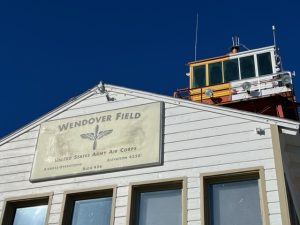
I have always enjoyed seeing places of historical importance, with their evidence of importance hidden in plain sight. Virginia City, Nevada is such a place. To most of the visitors, it is simply an old western town whose shops now sell ice cream and T Shirts.
For those who know the history, it’s where Samuel Clemens became Mark Twain. It’s a place that produced so much silver that it built San Francisco, and was the beginning of a few major corporations today.
The Wendover Airfield is another such place. My curiosity about it was built over some years. On a past cross country trip of some years ago, I stopped there and saw dozens of old wooden buildings whose condition reminded me of the Bodie State Historic Park, which is kept in “arrested decay”. And there was a huge hanger just to the east of the main facility. It looked a bit different from a typical hanger, as it had offices or workshops all along the sides.
Hidden in plain sight.
At its height, it was a small city with nearly 700 buildings dedicated to training bomber crews, with 100 bombers in the air at any given time.
Last November, I spent a bit more time there, going into what was the officer’s club, now a museum. I learned from someone there that they trained most of the heavy bomber crews from WW2. I remembered an old movie from the 50s, Above and Beyond, telling the story of Paul Tibbets and the 509th Composite Group and their time at Wendover.
Wendover is probably best known for the 509th and their preparation for dropping the atomic bombs on Hiroshima and Nagasaki. But they were also a major training center for heavy bomber crews, the B-17, B-29 and B-24.
I asked someone at the museum how many crews were trained here and was told “all of the B-17 crews, all of the B-29 crews, and some of the B-24 crews”.
I learned later that B-17 crews could have been trained elsewhere but I think it is safe to say this was a main training and staging base.
This is where each bomber crew were brought together and met for the first time. They all had their individual primary training and then came here for advanced training in their various roles bombardier, gunnery, and piloting. It is here they would learn to work as a team. One crewman in an interview said that they were more like a family, depending on each other.
None other than General Douglas MacArthur said that Wendover trained the best gunners.
I learned at the Museum last November that on April 22, they would offer a guided tour of the base. I signed up for it and was looking forward to it for months. It was worth the 550-mile drive from home!
Wendover Airbase resides right on the Nevada-Utah border, in Utah. It is literally 15 miles or so to the entrance of the Bonneville Speedway on the Salt Flats.
I was a bit concerned about when to meet (10:00) because Nevada is on Pacific time and Utah on Mountain time. Then someone told me that the whole town uses Mountain time. On the Nevada side reside some large casinos and they are of course completely gone a few hundred yards away on the Utah side. One of them, the Montego Bay, has the parking lot in Utah.
The property tax calculation must be interesting.
I can imagine what Wendover was like 80 years ago, minus the casinos. It is in a desolate area on the high desert, with Salt Lake City about 120 miles east and Elko is about 100 miles to the west.
I was told that the Army picked Wendover because it was far enough inland they didn’t have to worry about a Japanese attack, with still easy access to the West Coast. Right after Pearl Harbor, the entire West Coast was jittery about an expected attack.
The tour started promptly at 10:00, led by 3 docents. In 1970, the government turned the base over to the city of Wendover. In 1975, it was listed in the National Register of Historic Places. Today, the Historic Wendover Airfield (HWA) Foundation is dedicated to restoring and preserving the critical buildings. They can’t save it all, as the original airbase was almost 700 buildings, but their list of accomplishments, including the Enola Gay Hanger, has been impressive. Along the way in the mini bus while passing a huge empty field, one of the docents was saying that this field used to have dozens of enlisted barracks. Even today you will see many in a very dilapidated condition, after 80 summers and winters attacking the bare wood. They were originally built not with durability in mind, but speed, with tar paper roofs.
When the Wendover Airbase was formed, the government included 1.8 million acres. Some of that is still used today by the US Air Force as a test range. During Wendover’s time, the area for practice bombing run was 45 miles wide and 85 miles long. It had 4 active runways. Today it is a sleepy general aviation airport, with the 2 used runways still about 10,000 feet.
The HWA Foundation is working smartly, leasing hanger space for current aircraft. There were 7 hangers, including the Enola Gay hanger, of which 6 survive. You will see many with aircraft inside generating rental fees. I had to smile while in the Enola Gay hanger, seeing among its tenants a Grumman Albatross and a Cessna 172. This hanger was designed to accommodate 2 B-29s, nose to nose, and to see a little Cessna inside made me think of Jonah and the whale.
With this introduction, let me give you a virtual tour.
We started where we rendezvoused, at the former Officer’s Club, now restored and serving as the museum. Inside was a replica of the first atomic bomb, “Little Boy”. On it were the autographs of all those who were on the Enola Gay for that fateful mission, including mission commander Paul Tibbets.

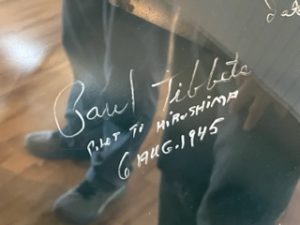

“This sign was put up in 1944 when the Manhattan Project Work began at Wendover Air Base.
Col. Paul Tibbets warned the members of the 509th Composite Group that security violations would not be tolerated and this sign was a reminder of the secrecy of their work.”
I had heard that during the Manhattan Project, the Boeing Company made an “atomic version” of the B-29 called a Silverplate. Among the differences were, instead of 4 bomb bay doors, one 30′ bomb bay door.
Knowing that a lot of work was still done at Wendover modifying these B-29s (Enola Gay and Bockscar among I am sure others), what exactly was done at Wendover to modify these Silverplates? The answer surprised me.
While the actual bomb was developed at Los Alamos, New Mexico and tested at the Trinity site, development of the actual bomb casing that which contained the device and which resided in the bomb bay, was developed at Wendover, under Project Alberta. The Trinity atomic device, which they called “The Gadget,” was spherical. Specifically, I do not know whether the actual development was done on base, but it was assembled, tested, and modified at Wendover. Because of the extreme security, subcontractors might send their parts to a 3rd location, where they would be forwarded to Wendover. Subcontractors never knew the ultimate destination of their parts.
The bomb bay of the Silverplate B-29s had to be modified to accommodate both Little Boy (Hiroshima) and Fat Man (Nagasaki), which were 2 very different casings.
Since the bombs weighed around 10,000 lbs, for the initial testing the casings were filled with concrete. Later they were filled with conventional explosives. Since they were designed to explode at 1800 feet, a radar altimeter was used in the bomb which also had to be tested. The practice atomic bombs were called pumpkins. Because we had never bombed at 30,000 feet, we had to learn new techniques.
Later in the tour, we were shown the loading pit. To the untrained eye, they were simply a concrete hole. But they explained how it was used. First a truck with a crane would deliver the bomb. The crane would lower the bomb onto a hydraulic cradle, which would then lower the bomb into the pit.
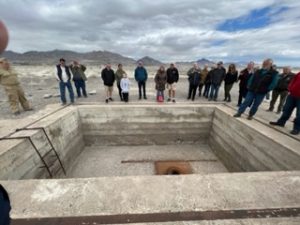
The docent told us that with the 10,000 lb bomb it was quickly discovered that it would raise the front wheels of the truck while lowering, so a very low-tech solution was used having 4 airmen sit on the front bumper as the bomb was being lowered!
Once the bomb was in the cradle and lowered into the pit, the B-29 would taxi over the pit where the hydraulic ram would raise the bomb into the bomb bay.
A similar pit is on Tinian Island.
From the museum, our first stop was at one of the hangers, specifically hanger number 2. This was where maintenance would be done on the bombers, such as an engine change. They were designed to hold a plane as large as a B-24, with a 5′ clearance on each side. The 1st 6 hangers were all 120′ wide.

This hanger had as its tenant a company that had T-33 jets. The docent then had us look towards the ceiling for some more “hidden in plain sight” data the trusses holding the roof were not steel, which was rationed and in short supply in WW2, but wood. He explained the construction process they used, which I have forgotten. But the wooden trusses, or beams, are still as strong as ever.
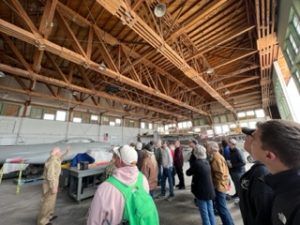
From hanger #2, we went to a restored barracks for enlisted men. There had to be 100s of these at one time, and many weather-beaten remains can still be seen. They were assembled with speed in mind, and not durability. There were 3 pot-bellied heaters down the center section, and bunk assignment was by rank, the higher the rank the closer to the stoves. You could see some of the boards were not weather tight, with daylight showing and I can imagine on the cold winters, which got down to zero, in those barracks at night. Also, the latrine was a couple of hundred yards outside!
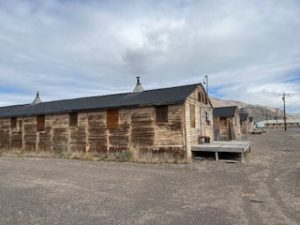
I could imagine soldiers waking up in the middle of a cold windy night wondering if they really wanted to walk down to the latrine in their skivvies! With no place to really go on the little time they had off, I can imagine what these soldiers thought of Wendover. A docent laughed and told me that “one of them wrote a poem about it!” So after 80 years, Pfc Lavaun Manning has his poem on the Net.
Of all the bunks in that restored barracks, one was left without blankets to signify the death of that soldier. Can you imagine the feeling of friends on station to come back and to see 7 or 8 now-empty bunks from a bomber that failed to return? I will talk more about this later, but in my reading of the 8th Army Airforce in East Anglia, a wonderful book recommended contained short reminisces of British and Americans during that time. One American serviceman remembered being with his crew just arriving in England and assigned to a Quonset hut but discovering that it was unlivable. All of the uniforms and personal effects of previous crewmen who paid the ultimate sacrifice were still piled everywhere in the space. They borrowed a wheel chair and removed all their personal effects and foot lockers of those men. And it took them 3 days.
It was pretty sobering.
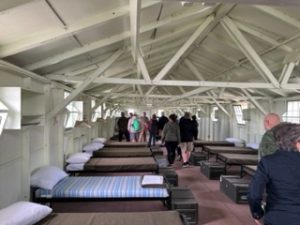
Note the unmade bed, signifying a causality.
Now imagine being on station, coming back after a difficult mission, and seeing 7 or more of these bunks all from crews of less fortunate planes.
From there, we moved a bit further to see what was the medical center. One building was the morgue there were 180 reported deaths at Wendover (I am surprised there weren’t more) and a visit to the nurses’ quarters. The nurses probably had the best accommodations on the base.
Then we moved to the location where supplies were brought in by train. One could still see the rusty railroad tracks, although the building was long gone. To give you an idea of the immense size of this base, a docent read a report of one day, saying that over 800 lbs of meat was rejected.
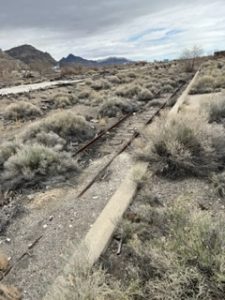
From there was a short trip to the mess hall probably to be more accurate a mess hall, with the food lockers still there after 80 years.
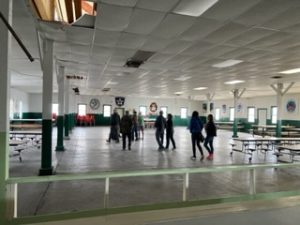
Next was a trip to one of the ammunition bunkers and along the way we saw what a docent called a “Gun Butt” a berm that was used to sight in the 8 .50 caliber machine guns of a P-47 Thunderbolt.
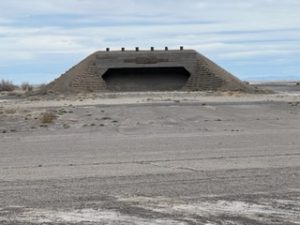
The bunkers were a few hundred yards apart a lesson learned from a 1926 explosion at a US Navy facility in New Jersey. There, the equivalent of 600,000 tons of TNT exploded in a chain reaction.
The incident at the Picatinny Arsenal prompted the United States Government to get serious about explosives safety. Shortly after the explosion, Congress created the Department of Defense Explosives Safety Board, a board that exists to “provide oversight of the development, manufacture, testing, maintenance, demilitarization, handling, transportation and storage of explosives” within the military.
Each bunker had a “blast wall” in the front to blunt any explosion that would occur, and they were separated (by my estimation) at least 200 yards apart.
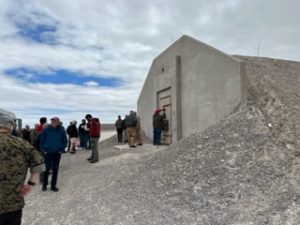
From here was a short trip to the atomic bomb loading pit, that I described earlier.
The Enola Gay Hanger (as I call it), #7, was huge, as you might expect. They had done a wonderful job of restoration, including fixing the roof. If I understood the docent correctly, this was just phase one, with more work to do. The main repairs that prevented more deterioration have been done. This was built in a matter of months. Along the sides were workshops and offices. Col Paul Tibbets’ office was upstairs and towards the front.
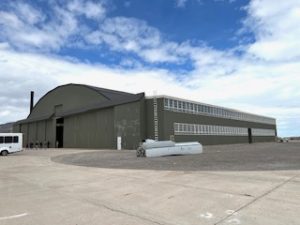
Col Tibbets’ office was second floor, on the front, right side (facing).
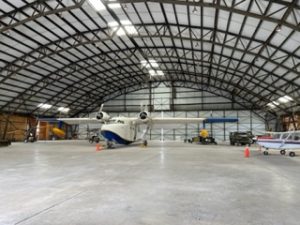
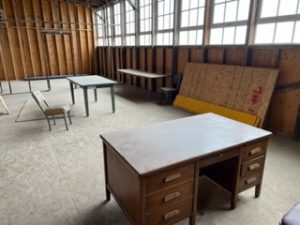
We then toured a building that was used to adjust and repair the Norden Bombsight. This was held under strict secrecy, although the docent was saying that while it was claimed that it could “put a bomb into a pickle barrel”, the docent added that was true, provided that the pickle barrel was ¼ mile wide!
Evidence of the value they had for these sights was seeing the 5 locked vaults that were used to store them.
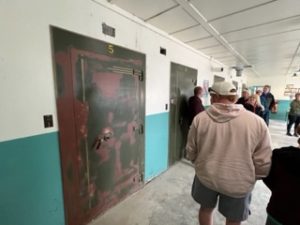
Towards the end of the tour, we went into a building that was used for a bombardier classroom, but after the war converted to the base fire house. There was a 1942 Army firetruck on display, which was Army olive drab. They said that they learned a lesson from Pearl Harbor, when the Japanese targeted the red fire trucks. What I thought interesting about this stop was learning that many airport firefighting techniques, including foaming the runway, originated in WW2.
A few final thoughts.
If you cross the San Francisco Golden Gate Bridge, once you get to the Marin County side there is a parking lot for the tourists to park and even walk across the bridge, if that is their desire. It is a beautiful photographic opportunity.
If you are observant, you will see a monument dedicated to the Sailors and Marines who passed under that bridge and had a last glimpse of their country. And for many it was a last glimpse, for they never returned.
I was moved by that monument, and the thought came to me that for many airmen their time at Wendover was their last experience in the US. I have been reading a bit on the 8th AAF, and followed one crewman’s story of leaving the US in a new B-17 for their destination of East Anglia. While they thought that the new plane would be theirs (and many had them already named with their own nose art) they would learn upon arrival that being the “new guys” they would be issued an old battle-scarred plane with a more experienced crew getting the new plane.
There over Europe they would face horrors they couldn’t have imagined. More airman in the 8th AAF alone were killed over Europe than all of the Marines in the South Pacific. I’ve heard different numbers used, and they probably changed over the period of 1942-1945 (when “The Mighty Eighth” would amass an armada of 1000 planes for attacks on Germany), but at least early on one’s odds were 1:3 of being killed or wounded before the required 25 missions were completed. That requirement was raised to 30 and finally 35.
In a wonderful DvD I reviewed, one veteran, in describing a typical mission, said that with every mission start he had a feeling akin to being led to a wall ready to be shot. Would this be the day?
There were many ways to die in a B-17, B-24 or B-29. The most common, I believe, was flak from the enemy. And in a formation, you had to maintain your course or you could create more danger to the other planes. So the flak gunners could adjust their aim. Of course, there were fighter attacks, mid air collisions while forming up (which, with a lot of planes, would be very intricate with assigned altitudes and positions). If you were out of position, or the plane above you was out of position, you could even die from a bomb dropped from above.
You could die at the end of a runway with a bomb laden plane and an engine going out. Or you could die coming back with a badly shot up plane that just couldn’t make it back to the airbase.
And yet they went out, day after day.
Some have said that the use of atomic bombs on Japan was wrong, even immoral. I am not one of them.
This was an illuminating few days I spent driving and touring the base. I felt as though I was stepping back into history.
I’d like to thank the docents of the HWA Foundation for such an informative and well-prepared tour.
If you would like to help with their restoration, here is their website.
Cross Posted at The Lexicans
I wish I’d known about Wendover a few years back when I was working at Idaho National Laboratory. It was just a short drive away by western standards. I know some bombers crashed on the lab grounds on training missions during the war, but I’m not sure if they flew from Wendover or another base in the area. Speaking of hangars, a huge one still exists at INL, built to house the proposed nuclear-powered bombers. Fortunately, that ill-advised project was canceled in 1963. The hangar is connected by a track with four rails designed to carry the massive, heavily shielded locomotive that was to be used to move the reactor cores back and forth. The locomotive can still be seen at the local EBR-1 Atomic Museum, along with a couple of the proposed atomic engines. Talk about plumbers’ nightmares! You can see pictures of them at the museum’s website.
Here’s Part 1 of a very good interview with Tibbets:
https://www.youtube.com/watch?v=qG2n3EmNtqY
And Part 2:
https://www.youtube.com/watch?v=UelE357z58M
Thanks so much for this detailed post.
Death6
I’ll have to go back and check in the series of letters that my uncle James wrote about his training as a gunner on a B-17 crew in late 1942 to mid-1943. I transcribed all the letters that he wrote to his family during that year. (A good thing, as the original letters were destroyed when my parent’s retirement house burned in 2003.) He did initial military training in Florida, and IRRC, did gunnery training at what is now Nellis AFB – part of this involved skeet-shooting from the back of a truck going at high speed, which rather sounded like fun. His crew was assembled at Ephrata Army Air Base, in Washington, and did further flight training from there. They had been issued a new B-17, and flew it over to England in the summer of 1943, but as you noted – the new AC went to the replacement depot, and they were assigned to another, when they arrived at Rougham AB. They nicknamed the AC “Lonesome Polecat”. but never had a chance to have the nose painted suitably. They were shot down on their first mission over Germany – the mass raid on the ball bearing factories at Schweinfurt.
A cousin of mine was a B 17 bombardier flying out of north Africa where they had to do 50 missions. His only wound was from flak. I once asked him what their escort was. He said “P 38s and ME 109s.”
On Col Tibbets. Many of you have probably seen the movie “12 o’clock high.” It is a fictionalized story about Frank Armstrong who commanded the 306th bomb group in England. The movie multiplied the group number by 3 and it became the 918th. It shows Gregory Peck, who played the Frank Armstrong role, leading the first 8th AF mission into Germany. In actual fact, Tibbets led that mission with Armstrong as co-pilot. Tibbets was the most experienced B 17 pilot in the 8th AF. Armstrong was new. Later, Tibbets was returned to the states to train the 29 crews who would drop the Bomb.
They were shot down on their first mission over Germany – the mass raid on the ball bearing factories at Schweinfurt.
Did your uncle survive ? A squadron mate of my cousin sent me his medals. I was 5. The fellow who sent me his medals was shot down before they arrived.
No, Mike – he was killed along with two of the other gunners before the survivors bailed out over France. I tracked down the last two survivors of the Polecat crew in the early 1990s, when I was still active duty myself. The navigator’s parachute failed and he died also. Of the survivors, one was captured, but the remaining crew were rescued by the Underground and smuggled to Switzerland. The local Underground leader also took a picture of where my uncle and two others were buried in the town cemetery, and had it smuggled out as well. I swapped letters at the time with the last two survivors and with M. Mathy. They are all gone, now.
Thank you again for this description of Wendover. I did not know that it still existed as a museum, and I might try to visit it if I last that long.
There are ghosts at places like that you can feel. The spirit of the different sort of Americans that they had in those days. Decades ago, I visited Camp Hale here in the Colorado mountains. That is where the then newly created 10th Mountain Division learned to deal with alpine mountains. All that was left were the concrete foundations of the barracks, but it seemed that you could feel those who were there, then. A few years ago, I was able to trace my late father’s unit and service history in some detail. He was in what was then called the 71st Light Division [it later was renamed just the 71st Division], which was trained for mountains and desert warfare. And I found out that immediately after the 10th Mountain left, the 71st came to Camp Hale, and went through the exact same training as the 10th. I never conceived of my father being able to climb mountains and rappel, back when I was learning to do some of that in college. So some of what I could feel may have been my father’s presence. If I can, I intend to go back.
Subotai Bahadur
I have read Anderson’s statement several times, the most mild reaction I have is: What the hell does he read in terms of fiction? The essence of good fiction is the distortion or obfuscation of reality, relationships, motives and intent. Every murder mystery can be “abstracted” to: “so and so did it.” Not going to make many royalties off that. Trying to abstract some sort of “scientific” truth through layers of authorial imagination, and intent is insane.
As an example, take Hardy’s “Jude the Obscure”. The main characters range from eccentric to homicidally psychotic. I completely fail to see what is usable in terms of reasonably normal people. On the other hand, throughout the book, Hardy does a brilliant job portraying the changes to working class British society by the increase in mobility and opportunity with the advent and expansion of the railroads. Certainly better than spending any number of hours pouring over tables of statistics.
I think the most important part of good fiction is to get the background right, you can then get away with just about anything as far as your characters.
Sorry, wrong thread. The hazards of having many tabs opened at once.
Throughout the Mountain West as well as the South are countless abandoned military bases from WW II. 25, 30 years ago you still could find some people who had first-hand experience of what it was like at these camps and air strips during the war and for a cup of coffee would tell you. I would accompany some history graduate students who made those trips to collect such oral histories. Not so much anymore, those memories are now as gone as the buildings and pavement.
I remember the opening scene of Twelve O’Clock High when Gregory Peck went back to the air base years after the war. Everything was quiet then but beneath the surface, especially in Peck’s face, you could still feel the tension of war, of bombers preparing to launch and do battle, of men about to launch into the heart of violence.
Bill was right about the terrible odds in flying in the 8th Air Force. Fly enough missions and the odds caught up to you, same as with the fighters and the infantry. That’s why crews and infantry were rotated out after so much time because you wanted to both capture their experience for stateside training and give them some hope of survival.
I would read accounts of American air raids conducted during the last year or so of the Pacific War when we had total control of the skies and would rack of kill ratios of 10 to 1 or flatten enemy installations with only the loss of a dozen planes and thought even with those odds how long would an American pilot last until the odds caught up with them. Maybe better than with the 8th over Europe, but flying fighters or serving in a rifle company or sailing subs was not a way to long life.
More appropriate. I recently spent a few hours at the Vicksburg park. There is a drive that takes you first along the Union line as it winds along a ridge and then along the Confederate line, often less than 100 yards away, separated by a deep and now wooded ravine.
All along are plaques put up by the Park Service with the names of the various units that occupied that position. Near the turning point between, is the cemetery with line after line of small stone markers. Scattered along the drive are also more elaborate monuments commemorating some of the states and some individual units. As far as I know, I have no relative there, but I imagine many visitors over the years have sought out the place where one of theirs had fallen.
I have said here before that the respect shown to the defeated Confederates after the war is probably unique in history. It is probably why so grievous a wound did not prove ultimately fatal to the Union. It is not something to be destroyed to make some momentary partisan point.
One of my posts about my search for Uncle Jimmy’s crew. In going through my maternal grandmother’s effects after she passed away, my father found a picture of his B-17 crew – and asked me if I could find out anything at all about them, including their names.
I did hours of search and letter-writing to all kinds of groups and people in the early 1990s, and talked to the last two survivors then. (They have both since passed away). I don’t think I ever re-posted all that I discovered – it was quite an epic.
https://ncobrief.com/index.php/archives/old-pictures-black-thursday/
Part one – https://ncobrief.com/index.php/archives/old-pictures/
The final conclusion – https://ncobrief.com/index.php/archives/old-pictures-smuggled-out/
Some excerpts from Uncle Jimmy’s letters – https://ncobrief.com/index.php/archives/old-pictures-the-polecat-crew/
Thanks, Bill.
You’re welcome everyone – it was my pleasure. I try to give it such detail that you also took the tour!
And Jonathan – I am conscience of the picture size – space is at a premium for most blogs – I let my iPhone shrink the pictures to “small” – most around 60K – except for the top one of the control tower.
What got me was the immense size of this place – and it continued what is across what is now I80 – was US 40 – in the mountains by the Bonneville Salt Flats. There they taught aerial gunnery. It wasn’t on the tour as it is about 10 miles away – or more – and just ruins.
– I have a longtime friend who loves to go hunting in WY – and one year he went exploring back in those hills. That is where they trained the aerial gunners and they had a large wooden track in an oval – with an unmanned and motorized jeep would tow targets while 3 students sat in another tracked movable platform – using .50 caliber machine guns. It was about the most realistic training you could get short of shooting at fighters while flying.
I wanted to go exploring back there but the road started deteriorating – and I didn’t have an SUV. But that area was picked because it was surrounded by mountains where .50 caliber bullets wouldn’t hit people. My friend said you could actually pick them off the ground – millions were shot there – and I bought one at a souvenir shop.
http://wikimapia.org/10392162/Tokyo-Trolley
Mike K – it has probably been 40 years since I saw Above and Beyond – and I remember them recruiting Tibbets in the 8th AAF – didn’t know he was the top pilot but would certainly explain why he was picked for such an important mission. I think I will try and find that movie again. It was a strange feeling visiting the office where he undoubtedly spent so much time.
Subotai – one of the eeriest places I visited of WW2 vintage was the site of the Manzanar camp right off US 395 – shortly after you climb out of Death Valley. It was dusk and it was a contrast between the beautiful backdrop of the eastern slope of the Sierras vs what was the primitive conditions of the camp. About all that remains besides the foundations are the guard tower and the gate. One could almost sense spirits there.
And yet so many of the sons of these Nisei volunteered for service to form the 442nd Regimental Combat Team which became one of the most decorated unites in the Army.
Sgt Mom – my hat is off to all of them – such death at your back with each mission and yet they went back up – again and again.
Mike K. has written about visiting the beaches at Normandy. And the cemeteries. There likely won’t be any American monuments in Vietnam, though the Vets returning have been met with decency and civility. Nor to the convoys in Iraq and the patrols in Afghanistan. Yet they went out, day after day in duty to American ideals, as they were understood then. The present powers that be, who will never hear a shot fired in anger, seem to take for granted that there will be more when they need them. I wonder if they’re right.
More appropriate. I recently spent a few hours at the Vicksburg park. There is a drive that takes you first along the Union line as it winds along a ridge and then along the Confederate line, often less than 100 yards away, separated by a deep and now wooded ravine.
My great great uncle, William Kennedy the brother of my great grandfather, was wounded at Vicksburg on May 22, 1863. I have his letters to his wife. He reassured her that his wound was not severe and that he would be shipped north to Memphis, past Vicksburg at night, That was his last letter. The next one to his wife was from a sister of the man in the next bed at Gayoso hospital telling her that her husband, William, had died on June 2. May 22 was the last frontal attack by Grant, after which he began the siege that ended on July 4 with surrender. It rained that day he was buried and the names were washed off the wooden coffins so she never was able to visit his grave.
I remember the opening scene of Twelve O’Clock High when Gregory Peck went back to the air base years after the war.
It was Dean Jagger who played the adjutant. He got an Academy Award for that role.
The real Greg Peck character, named Frank Armstrong, went on to be a Lt General in the USAF.
Because he had not yet been checked out as a combat pilot in the B-17, Armstrong flew the first mission as the co-pilot of a Fortress piloted by Major Paul W. Tibbets, one of his squadron commanders.
Armstrong returned to the staff of Bomber Command until January, 1943, when Eaker again used him to rebuild another bomb group performing below standards. From January 4 to February 17, 1943, Armstrong commanded the 306th Bomb Group at RAF Thurleigh, England, and led the first mission by the Eighth Air Force to bomb Nazi Germany. His experiences with the 97th and 306th groups became the basis of Sy Bartlett and Beirne Lay Jr.’s novel and film Twelve O’Clock High. While in command of the 306th, Armstrong led the Eighth Air Force on its first mission to attack a target in Germany on January 27, 1943.
“…but at least early on one’s odds were 1:3 of being killed or wounded before the required 25 missions were completed.”
More like 1:1. My father was a B-17 bombardier in the Mighty Eighth. As he put it, the brass didn’t know what to do with the airmen who completed 25 missions because they weren’t supposed to be alive.
Do the math: a mission with only 4% losses would be a pretty good day. 25 x 4% = 100%.
And yet Dad volunteered for the Air Corps. We talked about it. He said that it seemed like a much better alternative than carrying a rifle in the rain and snow, and sleeping in muddy trenches. In the Air Corps, you got to fight sitting down, and had a hot meal and a warm bed every night.
He even volunteered for an additional ten missions, on the promise of promotion to captain. But a new unit commander reneged on that, saying that only pilots should be captains or above. So he quit after five extra missions.
We toured the Collings Foundation “Wings of Freedom” B-17 together, and he showed me his position in the glass nose. Looking straight down from 30,000 feet… I can hardly imagine doing it at all, much less over Berlin with flak exploding all around. (He went there twice.)
“It was Dean Jagger who played the adjutant. He got an Academy Award for that role.”
Well Hells Bells no shells… I need either glasses or to change my meds
This comment thread has inspired me to read up (yet again) on Jimmy Stewart’s time with B-24s in Europe and up to serving as an observer on Arc Light missions in Viet Nam. I’ll put him in the pantheon with Ted Williams (who for a time was John Glenn’s wingman)
Rich I have never ridden in a B-17 but I got to go on both a B 17 and a B24 for a small fee when they landed at our airport.
I couldn’t get over the size of the catwalk that went over the Bomb bay.
Maybe a little over a foot wide?
Then imagine being at 20,000 feet or more at 50 below zero and you’re working in that environment with electrically heated suit
Mike K
I really recommend that book American bomber boys. There must be 100 or 200 little reminisces from both British civilians and American servicemen about their time in east Anglia
There is a picture of Clark Gable talking with Jimmy Stewart
At least I think it’s in that book
I am of the opinion that after Clark Gable’s wife was killed he volunteered for this as a way to commit suicide
As for Jimmy Stewart he had the admiration of everyone who knew him there. There’s one quote from a service man who knew him saying everybody respected him as he went on missions very dangerous that he didn’t have to go on
It affected him so much he didn’t know whether he wanted to stay in the movie business and Frank Capra’s movie it’s a wonderful life was the first movie he was in Post war
Frank Capra I believe was one of those five directors that went overseas to make movies for the War Department
But the anguish you see and hear his part in the movie was real from his post traumatic stress
Wompatuck State Park in Hingham, MA was originally an ammo depot. There are still dozens of concrete bunkers scattered through the woods with remnants of the tracks that serviced them still visible. I doubt many of the thousands of visitors know anything of their history or purpose.